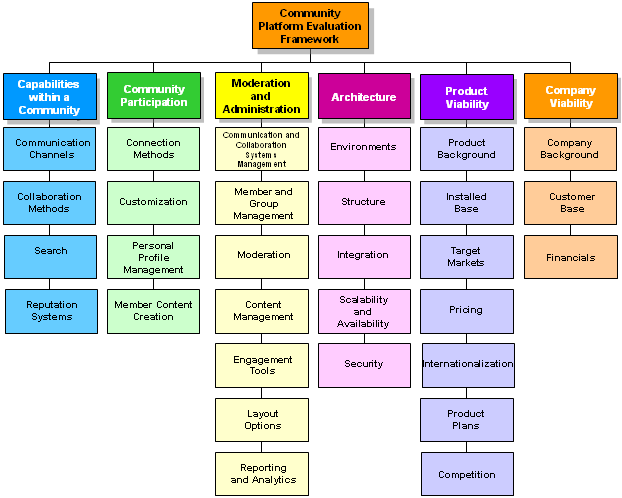Framework for Evaluating Online Community Platforms, Version 3
How to Evaluate Solutions that Enable Online Customer Communities
Online communities can empower customers and strengthen the relationships between them and your company. This happens through careful planning, assigning sufficient resources, and selecting the right tools. While the human element is a crucial factor, the underlying technology platform plays an essential role in your community’s success. We’ve developed this framework to help you evaluate such platforms and identify the one that’s best for you. This third version reflects the technological advances and increased expectations for what community platforms can and should be able do, including an emphasis on collaboration, viral marketing, search engine optimization, and mobile access.
NETTING IT OUT
Online community platforms are becoming more and more prevalent as part of companies’ online toolkits. Built initially with only basic forums (a.k.a. message boards and threaded discussion lists), they continue to develop dramatically in scale and scope, providing arrays of features and capabilities for community members (your customers), moderators, administrators, business sponsors, and other key stakeholders.
Customer communities can empower customers and strengthen the relationships between them and your company. This happens through careful planning, assigning sufficient resources, and selecting the right tools. While you should never discount the human element in achieving your goals, the underlying technology—your platform—also plays an essential role in your community’s success.
We’ve developed this framework to help you evaluate online community platforms and identify the one that’s best for you. This third version reflects the technological advances and increased expectations for what community platforms can and should be able do. The past year has seen many changes in the online community space, including an emphasis on collaboration, viral marketing, search engine optimization, and mobile access. To address these and other changes, this framework contains new and updated customer scenarios and criteria for evaluating community platforms.
EVALUATING ONLINE COMMUNITY PLATFORMS
What’s New in This Version
This report is the third version of our online community platform framework. It takes into account current trends, increased expectations, and new technologies since the last version was published in January 2008. New sections and criteria in this version include:
- Discussion of the evaluation process from two perspectives: (1) identifying a platform to support a new community, and (2) identifying a platform to which an established community will be migrated (as would be the case if your are unhappy with the existing platform, or if the community has outgrown its capabilities)
- Addition of several Collaboration criteria: Idea Engines and Presence Awareness
- Addition of Community Participation criterion: Viral Tools (such as “Invite a Friend” and “Send to a Friend”)
- Addition of several Architecture criteria: Search Engine Optimization (SEO) and Support for Mobile Devices
Online Community Evaluation Framework

© 2009 Patricia Seybold Group
Illustration 1. This illustration shows the top-level criteria and their subcriteria for our online community plat-form evaluation framework.
Selecting an Online Community Platform
Building a successful customer community has become a core competency for many customer-centric organizations. It is also a key differentiator that can lead to competitive advantage, which is one reason why more and more companies are committing more internal resources to manage and facilitate such communities. At the same time, software vendors are evolving and/or shoring up the software platforms they use to host these online forums. The purpose of this report is to provide a useful evaluation framework you can use to select the online community software platform (either in-house or hosted) that best meets the needs of your organization and customers and can help you successfully achieve your and your customers’ goals.
Evaluating a Platform for a New Community
To start a successful online customer community—whether your customers are looking primarily for answers to questions, for fellowship, to meet new people, for fun, or for opportunities to contribute— you’ll want to think carefully about the different audiences you seek to attract and about the needs of each of your main external (and internal) audiences. But beware…this isn’t something you can predict or plan with absolute precision. An online community is organic; you can guide and nourish it, but ultimately it will grow in the direction the community wants it to go. (Gardening analogies, though trite, are not inaccurate.)
While your long-term goals should be large, your community will likely start out small. (In fact, it’s almost impossible not to start out small.) In this regard, the technology platform you use should comfortably support the needs of your small nascent community. But the platform should also be able to grow with your community in terms of both functionality and technological infrastructure.
Evaluating a Platform for an Established Community
Not all online community platform evaluations are in search of a first platform. More and more, as the market matures, companies are looking to move existing communities from one platform to another. This might be done because the business has changed, because there is unhappiness with the current platform, or because the community has outgrown its first platform in terms of scale and/or functionality.
For the most part, evaluation criteria are the same whether you’re launching a new community or migrating an established one to a new platform. But there are differences, the most important being that, if you’re moving the community to a second platform, you should already have a pretty good sense of your platform requirements and their relative priorities. In this case, you should already know what’s important to your community members, your moderators, your technology team, and others. And you’ll know what you (and your members) liked and didn’t like about the platform you’re looking to leave. Both these factors will be a great help in making a good decision.
If you’re migrating from one platform to another, one criterion not explicitly discussed in this framework relates to the data migration process. When switching platforms, you’d ideally like as much content and information as possible moved from the old platform to the new one (e.g., member account and profile information, forum discussions, blog posts, wiki documents, group member lists, permission maps, time and date stamps, etc.). How easy or difficult this is depends upon both of these platforms. The most relevant criterion in this framework is the section on Architecture, which discusses the platform’s database structure. If you are in this situation, you’ll also want to find out about technical migration services provided by the platform vendor.
REQUIREMENTS FROM KEY CUSTOMER SCENARIOS
We see five distinct groups of people (summarized below) who have reasons to become involved with the community, look to get something out of their participation, and have a stake in its success. They are your customers, community moderators, community administrators, subject-matter experts, and business sponsors.
Each of these groups has its own needs, desires, and goals. We think in terms of Customer Scenarios—sets of tasks that customers (used here in the broadest sense) would ideally like to do in order to achieve desired outcomes. These scenarios become the foundation on which our platform evaluation criteria are based...
Sign in to download the full article
0 comments
Be the first one to comment.



